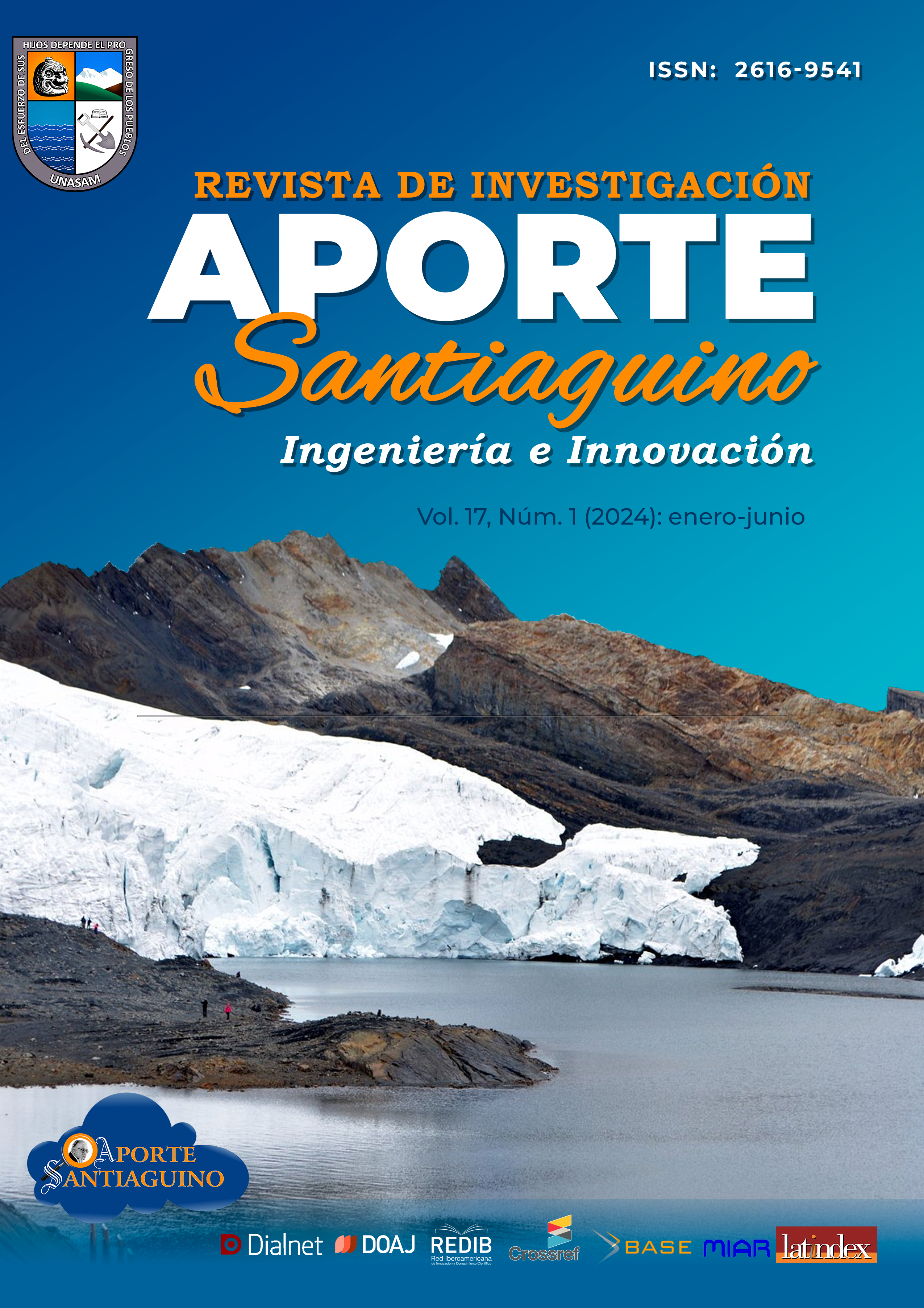Vegetal cover change evaluation in Quillcay river sub-basin using normalized difference vegetation index
DOI:
https://doi.org/10.32911/as.2024.v17.n1.1151Keywords:
NDVI, Landsat, wetlands, anthropogenic activity, Andean ecosystemsAbstract
In the Quillcay River sub-basin, located in the province of Huaraz, Áncash, Peru, changes in high Andean ecosystems are evident, represented by typical plant communities due to anthropogenic pressure. To evaluate these changes in the period 1987-2023, the normalized difference vegetation index (NDVI), Landsat L2SP TM OLI images and field work were used. It was observed that the NDVI increased in the lower part of the sub-basin due to the installation of exotic forest plantations in the buffer zone of the Huascarán National Park. In this park, the NDVI changes were negative in areas with high Andean grasslands and wetlands where various anthropogenic activities take place.
Downloads
References
Aburas, M. M., Abdullah, S. H., Ramli, M. F., & Ash’aari, Z. H. (2015). Measuring Land Cover Change in Seremban, Malaysia Using NDVI Index. Procedia Environmental Sciences, 30, 238–243. https://doi.org/10.1016/j.proenv.2015.10.043
Ahmed, K. R., & Akter, S. (2017). Analysis of landcover change in southwest Bengal delta due to floods by NDVI, NDWI and K-means cluster with landsat multi-spectral surface reflectance satellite data. Remote Sensing Applications: Society and Environment, 8(August), 168–181. https://doi.org/10.1016/j.rsase.2017.08.010
Annatakarn, K., Annatakarn, K., Fooprateepsiri, R., Suwanprapab, M., Supunyachotsakul, C., & Witchayangkoon, B. (2022). Finding Threshold for NDVI to Classify Green Area: Case Study in the Central Thailand. Journal of Hunan University Natural Sciences, 49(4), 325–332. https://doi.org/10.55463/issn.1674-2974.49.4.34
CENEPRED (2012). El Fenómeno El Nino. http://sigrid.cenepred.gob.pe/docs/PARA PUBLICAR/CENEPRED/Boletin Fenomeno El Nino.pdf
Chuvieco, E. (2010). Teledetección ambiental (1ra ed.). Ariel Ciencia.
Da Cruz, D. C., Benayas, J. M. R., Ferreira, G. C., Santos, S. R., & Schwartz, G. (2021). An overview of forest loss and restoration in the Brazilian Amazon. New Forests, 52(1), 1–16. https://doi.org/10.1007/s11056-020-09777-3
El-Gammal, M., Ali, R. R., Abou Samra, R., El-Gammal, M. I., Ali, R. R., & Abou Samra, R. M. (2014). NDVI Threshold Classification for Detecting Vegetation Cover in Damietta Governorate. Egypt. J Am Sci, 10(8), 1545–1003. http://www.jofamericanscience.orghttp//www.jofamericanscience.org.15
Garcia, E., & Otto, M. (2015). Caracterización Ecohidrológica De Humedales Alto Andinos Usando Imágenes De Satélite Multitemporales En La Cabecera De Cuenca Del Río Santa, Ancash, Perú. Ecología Aplicada, 14(1–2), 115. https://doi.org/10.21704/rea.v14i1-2.88
Huang, S., Tang, L., Hupy, J. P., Wang, Y., & Shao, G. (2021). A commentary review on the use of normalized difference vegetation index (NDVI) in the era of popular remote sensing. Journal of Forestry Research, 32(1), 1–6. https://doi.org/10.1007/s11676-020-01155-1
Ihlen, V., & Zanter, K. (2019). Landsat 8 Data Users Handbook. In Department of the Interior U.S. Geological Survey (Vol. 8, Issue November). https://landsat.usgs.gov/documents/Landsat8DataUsersHandbook.pdf
INEI. (2023). Directorio Nacional de Municipalidades Provinciales, Distritales y de Centros Poblados 2023 (INEI (ed.).
https://www.inei.gob.pe/media/MenuRecursivo/publicaciones_digitales/Est/Lib1903/libro.pdf
INRENA. (1996). Compendio estadístico de la actividad forestal de Perú 1980 -1996. Ministerio de Agricultura.
Instituto del Bien Común. (2016). Directorio de Comunidades Campesinas del Perú. In Instituto del Bien Común (Ed.), Instituto del Bien Común - IBC Centro Peruano de Estudios Sociales - CEPES (Primera). https://www.ibcperu.org/wp-content/uploads/2017/06/DIRECTORIO-DE-COMUNIDADES-CAMPESINAS-DEL-PERU-2016.pdf
Li, X., Chen, G., Liu, X., Liang, X., Wang, S., Chen, Y., Pei, F., & Xu, X. (2017). A New Global Land-Use and Land-Cover Change Product at a 1-km Resolution for 2010 to 2100 Based on Human–Environment Interactions. Annals of the American Association of Geographers, 107(5), 1040–1059. https://doi.org/10.1080/24694452.2017.1303357
Mallqui, H., Valverde, H., Rosales, J., & Rosario, A. (2016). Información de caracterización de la subcuenca del Río Quillcay. https://www.inaigem.gob.pe/wp-content/uploads/2019/05/Informe-Quillcay.pdf
Maron, M., Simmonds, J. S., Watson, J. E. M., Sonter, L. J., Bennun, L., Griffiths, V. F., Quétier, F., von Hase, A., Edwards, S., Rainey, H., Bull, J. W., Savy, C. E., Victurine, R., Kiesecker, J., Puydarrieux, P., Stevens, T., Cozannet, N., & Jones, J. P. G. (2020). Global no net loss of natural ecosystems. Nature Ecology and Evolution, 4(1), 46–49. https://doi.org/10.1038/s41559-019-1067-z
Marques, A., Martins, I. S., Kastner, T., Plutzar, C., Theurl, M. C., Eisenmenger, N., Huijbregts, M. A. J., Wood, R., Stadler, K., Bruckner, M.,
Canelas, J., Hilbers, J. P., Tukker, A., Erb, K., & Pereira, H. M. (2019). Increasing impacts of land use on biodiversity and carbon sequestration driven by population and economic growth. Nature Ecology and Evolution, 3(4), 628–637. https://doi.org/10.1038/s41559-019-0824-3
MINAM. (2021). Informe sobre el estado del ambiente 2014-2019. https://sinia.minam.gob.pe/inea/wp-content/uploads/2021/07/INEA-2014-2019_red.pdf
Ocaña, D. (1993). Desarrollo forestal campesino en la región andina del Perú. FAO/HOLANDA/PRONAMACHCS/PERU.
Salvador, M. (2000). Estudio de soportabilidad de pastos nativos de la quebrada Quillcayhuanca.
Sayler, K., & Zanter, K. (2021). Landsat 4-7 Level 2 Science Product (L2SP ). Guide September 2021 (Vol. 2, Issue September). https://www.usgs.gov/media/files/landsat-4-7-collection-2-level-2-science-product-guide
Sayler, K., & Zanter, K. (2023). Landsat 8-9 Level 2 Science Product ( L2SP ) Guide. In Department of the Interior U.S. Geological Survey: Vol. Version 5. (Issue March). https://www.usgs.gov/media/files/landsat-8-9-collection-2-level-2-science-product-guide
SENAMHI. (2014). El fenómeno El Niño en el Perú. In SENAMHI. https://repositorio.senamhi.gob.pe/bitstream/handle/20.500.12542/874/El-fenómeno-El-niño-en-el-Perú.pdf?sequence=1&isAllowed=y
SENAMHI. (2017). El Niño Costero 2017 Condiciones Termo-Pluviométricas a Nivel Nacional. http://sigrid.cenepred.gob.pe/docs/PARA PUBLICAR/SENAMHI/Informe_Tecnico_N_28_2017_SEHAMHI_DMA_SPC_El_Nino-
Costero_2017_Condiciones_Termo_Pluviometricas_a_Nivel_Nacional_Peru_2017.pdf
SENAMHI. (2019). Caracterización espacio temporal de la sequía en los departamentos altoandinos del Perú (1981-2018).
SENAMHI. (2023). Normales Climáticas Estándares y Medias 1991-2020. SENAMHI. https://www.senamhi.gob.pe/?&p=normales-estaciones
SERNANP. (2017). Plan Maestro del Parque Nacional Huascarán periodo 2017-2021. https://old.sernanp.gob.pe/sernanp/archivos/baselegal/Resoluciones_Presidenciales/2017/RP 064-2017-SERNANP.compressed.pdf
SERNANP. (2022). Memoria anual 2021. https://www.gob.pe/institucion/sernanp/informes-publicaciones/2918753-memoria-anual-2021
Taufik, A., Ahmad, S. S. S., & Ahmad, A. (2016). Classification of Landsat 8 satellite data using NDVI thresholds. Journal of Telecommunication, Electronic and Computer Engineering, 8(4), 37–40.
Vergara, A., Arias, M., Gachet, B., Naranjo, L., Román, L., Surkin, J., & Tamayo, V. (2022). Informe Amazonía Viva 2022. https://wwfint.awsassets.panda.org/downloads/lar2022_espanol_23_dic_2022.pdf
Vignon, F. (2002). Glaciares y recursos hídricos en el valle alto del río Santa. https://horizon.documentation.ird.fr/exl-doc/pleins_textes/divers12-06/010053310.pdf
Villanueva, R., & Del Valle, C. (2021). Modelamiento del crecimiento urbano de la ciudad de Huaraz mediante regresión logística. Revista del Instituto de investigación de la Facultad de minas, metalurgia y ciencias geográficas, 24(47), 201-210. https://doi.org/10.15381/iigeo.v24i47.20644
Wulder, M. A., Loveland, T. R., Roy, D. P., Crawford, C. J., Masek, J. G., Woodcock, C. E., Allen, R. G., Anderson, M. C., Belward, A. S., Cohen,
W. B., Dwyer, J., Erb, A., Gao, F., Griffiths, P., Helder, D., Hermosilla, T., Hipple, J. D., Hostert, P., Hughes, M. J., … Zhu, Z. (2019). Current status of Landsat program, science, and applications. Remote Sensing of Environment, 225(February), 127–147. https://doi.org/10.1016/j.rse.2019.02.015
Xue, J., & Su, B. (2017). Significant remote sensing vegetation indices: A review of developments and applications. Journal of Sensors, 2017. https://doi.org/10.1155/2017/1353691
Zanter, K. (2019). Landsat Collection 1 Level 1 Landsat. In United States Geological Survey (Vol. 2, Issue April). https://www.usgs.gov/media/files/landsat-collection-1-level-1-product-definition
Zhu, Z., Fu, Y., Woodcock, C. E., Olofsson, P., Vogelmann, J. E., Holden, C., Wang, M., Dai, S., & Yu, Y. (2016). Including land cover change in analysis of greenness trends using all available Landsat 5, 7, and 8 images: A case study from Guangzhou, China (2000–2014). Remote Sensing of Environment, 185, 243–257. https://doi.org/10.1016/j.rse.2016.03.036
Downloads
Published
How to Cite
Issue
Section
License
Copyright (c) 2024 Ricardo Villanueva Ramírez

This work is licensed under a Creative Commons Attribution 4.0 International License.




















